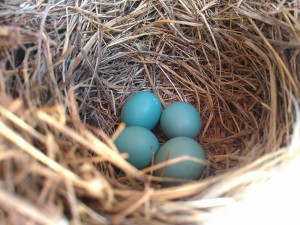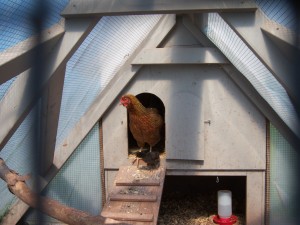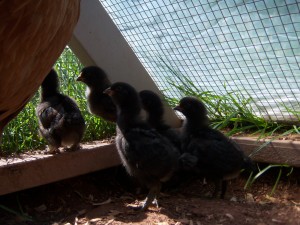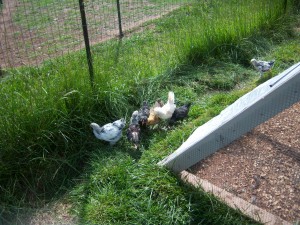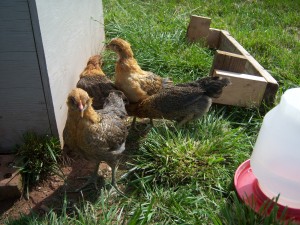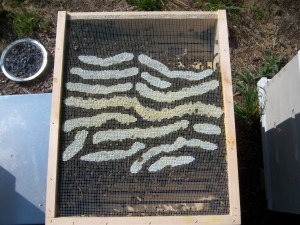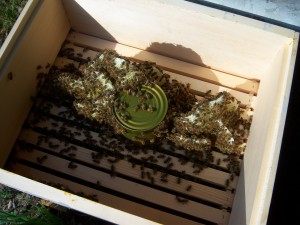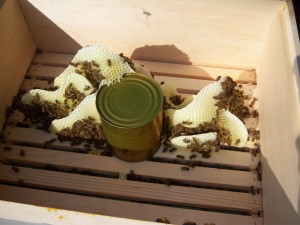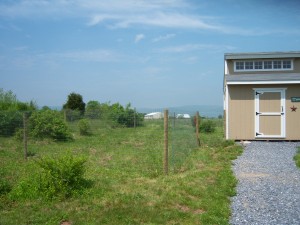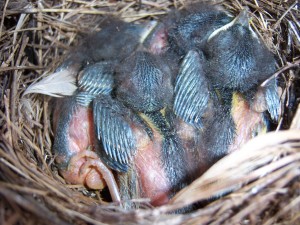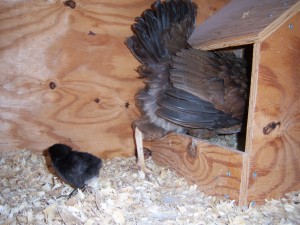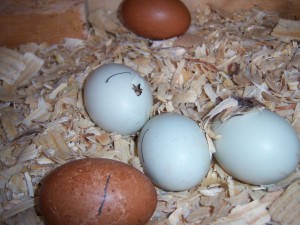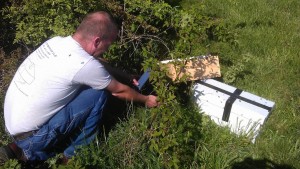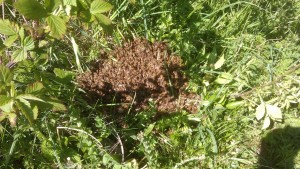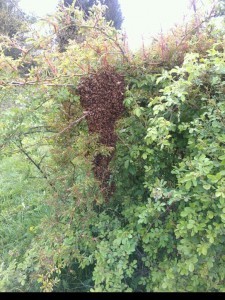
Chick update
0Daisy’s six chicks are doing very well. Daisy is doing a wonderful job of teaching them the life skills for being a successful chicken – scratching, pecking, and running away from any other creature, which is mainly us. Scooter and Erinn recently got one lonely chick from a broody hen, so we loaned out two of Daisy’s babies as companion chicks. The lone chick wasn’t doing so well on her own learning her life skill. I drew up the loaner chick rental agreement, but never got it signed. I’ll probably never see that six-pack of good beer. Two of the babies have developed some brown on their wings and they are the two with some feathers on their feet, so it seems like these two must be from the Maran eggs, but could be pure or could be half R.I. Red.
It is always fun to watch them grow up and see how the Cockerels develop, but then in the back of our minds we know their eventual fate and that is a little bit sad to think about.
The 14 six-week old chicks finally went outside for the first time over the weekend. It was a little traumatic at first – so much space and so much sun – but they eventually seemed to enjoy exploring. The grass was a little tall for them, but hopping and flapping got them around the nursery coop yard nicely. Daisy and her peeps were inside the nursery coop and the older one were outside the coop. This should give them a chance to get to know each other. A brief encounter between Daisy and the older birds, let us know that they aren’t ready to be put together yet.

Bee neglect
2It has been an exciting spring so far. All three of my hives swarmed and a fourth swarm showed up from I know not where. The garden is getting prepared and planted. The chickens needed more space and we have two groups of peeps being raising.
What hasn’t gotten done is routine maintenance on my two year-old hives and one seven-week-old hive. There have been so many reports of swarms this year, I wonder if it was just inevitable. I thought that one could prevent swarming by continuing to give the bees the space they needed to expand, but now I am not so sure.
My year-old hives both have two deep boxes for brood and have had medium honey supers on them for over a month. There was plenty of room for more brood in those boxes, but they swarmed anyway. I thought two deeps or three mediums was kind of standard for brood space and all that was needed after that were honey boxes.
So I am now wondering if maybe there are environmental conditions that result in swarming no matter what a beekeeper does.
A swarm can be good or bad. It is bad to loose half your bees, but a natural way to make a split if you can recapture your swarm. The bees take care of making the new queen and the timing is right because the bees handle the whole affair. The swarm is good if you want to expand the bee yard for the long term, but bad for honey. In two hives with 25,000 bees each, they are pretty busy with developing brood, but in a single hive of 50,000, you have twice as many to focus on gathering nectar and storing honey. I was hoping for a lot of honey this year. Maybe it won’t happen until next year now, but instead of two hives, I now have five (I gave two of the swarms away).
So about that neglect. Maybe being more attentive would have helped prevent swarming and maybe not. But in the meantime, the third hive of Georgia bees was installed in a single medium box, swarmed and has build lots of comb in the top feeding box which you can see through the screened inner cover. I looked at it yesterday, but didn’t deal with it yet. This colony swarmed just a week ago, so the new queen is not yet laying. I am tempted to add another brood box under the feeder and put a queen excluder on it and keep the feeder box and comb intact. I’m not sure if there is any brood in it, but I am hoping not. If not, then I might be able to harvest some comb honey later in the season. A bit non-standard, but what the heck.
The last two hives to deal with are the new hives from the swarms. The swarms that I kept were from my first hive and from the Georgia bee hive. Swarm one is now hive four, and it was also put into a medium box with a spacer box to hold the left over sugar syrup from the Georgia package. This is one of the standard ways to feed bees if not using a top box feeder. The problem is if you don’t look at the hive often enough, the bees will take advantage of that space and build free comb in it as you can see in the picture. I couldn’t keep this comb, so yesterday I did have to scrape this all out. There was no brood, but lots of almost ready to be capped nectar/honey. It pained me to have to scrape this all out, because of the wasted honey and even more so because of the wasted comb. I added new frames to that open box, but now the bees will have to rebuild all that comb. Bummer.

Second chicken yard
0We finally finished the second chicken yard a few days ago. The one-year-old chickens have completely eaten down the original yard and by moving the birds now I think the grass will come back. It’s trying, but with the chickens there it doesn’t stand a chance.
The new yard is about the same area or perhaps slightly larger. It is the area where I drove the little earth mover that I rented to excavate for the coop foundation so it is full of ruts. I tried to even out the ground a bit, but it is still quite lumpy. The chickens take advantage of exposed or loose dirt and ruts to scratch around in and take dirt baths, but sure makes it tough to cut the tall grass. The birds seem to largely ignore tall grass, so I want to cut it down to make it more appealing and give them some greens to eat. As it is they really just look for the dirt patches and scratch for bugs. I am hoping that the two yards will be sustainable – that is until we introduce more chickens. I can let them out of the yards to graze on the rest of the property, but we are refraining from doing that until the garden get more established. We don’t want them scratching up our tender little plants.
Fourth swarm
0Today I discovered the fourth swarm in the same shrub about 50 feet from my hives. At the beginning of the year I only had two hive. I added a third on in March. How did I end up with four swarms? I don’t really know. Maybe it came from off my property, drawn by the smell of the three queens who had very recently taken up temporary residence there. Whatever the reason, it was one too many swarms for me, so I passed it along to my neighbor and president of the Frederick County Beekeepers Assoc (FCBA). It all happened so fast that I didn’t even get a picture. And if I didn’t get a picture, maybe it was just a dream and never happened at all.
I also did an inspection of my Boston hive. It has been 17 or 18 days since the swarm from Boston, and I believe that the new queen would have been able to mature and get in her mating flights by now. I didn’t see her, nor did I see any eggs or larvae, but I am not going to worry about it. I will look for her or signs of here in another week or 10 days. I did something that I might regret. I swapped the top and bottom boxes again. I did this at the beginning of the season, moving the heavier/fuller box to the bottom. This time around the top box was again the much heavier one, so I moved it back to the bottom. I’m not sure this was a good idea, so I may just inspect and not swap the Anaheim hive boxes when I get a chance to inspect them.
First Harvest from the Garden!
0It’s so exciting to get the first veggies from our garden! The radishes are growing well in the raised bed and some that we planted in one of the large gardens are looking great for harvesting in another week or so. These are the variety Cherry Belle, a smaller radish with a mild flavor. Funny we never buy radishes at the grocery, but I always look forward to the clean, fresh taste of these right out of the garden.
We have lettuce, spinach, onions, peas, broccoli and Brussels sprouts all doing nicely in the garden right now. We seem to have a lot of rabbits in our area this spring so we are putting up fencing around the 2 large garden plots. The fence is really to keep the chickens out, too. They love to scratch around in the nice loose soil and I’m sure they would eat all the tender greens sprouting up if given the chance. They have not been getting their free range time for the last few weeks so we need to get that fence up ASAP.

Daisy’s chicks
0Daisy, a Welsummer hen hatched her chicks yesterday and this morning. She was setting on seven eggs. Yesterday the first one hatched out, the second one didn’t make it and died and the five remaining went into the night. I don’t know if chicks hatch out at night or somehow know when it is morning and wait, but by 9 am this morning I counted five. I might have missed the sixth one or it might not be hatched yet. We’ll know later today. She was setting on two Maran or Welsummer eggs and five Ameraucana eggs. There are only two roosters – a Maran and a Rhode Island Red – but the Red is dominant and seems to do most of the fertilizing. So they are likely Red crosses with a slight possibility of a pure Maran. All the chicks are black with the exception of the one that died.
When Tilda hatched her eggs two years ago, they were mostly black as well. I wonder if that is common for crosses. They might not stay black, but we’ll have to wait to see how they turn out when their feathers come in. Tilda’s crosses were nice big birds and the hens have been good layers.
We plan to breed the Maran with the three Maran hens this year, but I need to build another nursery coop before that can happen. I better get moving.

Swarm number three
0I recaptured a third swarm from my hives today. It took a couple of tries to get the queen into the nuc box, but they are all installed and quiet for the night. I weighed the nuc box and bees (12 lbs), and an identical nuc box without bees (5 lbs). At 3500 bees per pound, those seven pounds of bees amount to about 24,500 bees. This means that there had been perhaps 35,000 to 50,000 bees in that single medium brood box. No wonder they swarmed!
This swarm seemed about the same size as the other two and it landed on the same wild berry bush. Again, I only discovered this swarm by accident as I was walking the dogs. I believe I saw a couple of bees doing a waggle dance on the outside of the swarm, so they may have actually swarmed yesterday rather than this morning. I really appreciate these swarms that leave on the weekend. It was nice that Joni and I were both available. The swarm was about at chest height, but gathered around several intersecting branches which made freeing it up a bit more challenging than usual. It was also rather wide, so dropping it into a five-frame nuc box was tricky. I was able to free up the swarm so that it was primarily hanging onto one main branch. When I gave it a shake about two thirds of the bees ended up in the box and about a third outside the box. There was still a small cluster on the branch. This got the bees rather excited and I decided to step away to see if I had the queen. I was also stung twice. I was not wearing gloves. If I would have cut the branch down and held it closer to the box to shake, I don’t think I would have been stung. Lesson learned.
When I came back to the swarm after about 15 minutes, the bees were starting to gather back on the branch, so I cut that branch and lowered it into the box to shake off those bees. After another 15 minutes break, I felt pretty sure I had the queen, although there were still lots of bees on the outside of the box. I gave it a couple of hours this time and was finally able to get the lid on the box and then just before dark when the air had cooled and the bees were all inside, I moved the nuc box along side of the last captured swarm.
I have no top cover or bottom board for this hive although I do have a medium box and frames. The top and bottom are scheduled to ship tomorrow from Brushy Mountain Bee Farm in NC. I hope it gets shipped.
I wanted to do an inspection of my hives today, but the swarm and other chores got in the way. Hopefully I will get to it tomorrow. I peeked into the box that swarmed and there is a lot of burr comb hanging from the screened inner cover over the top feeder box. I will need to open the box to see what else is going on there, but there is a pretty good chance that the virgin queen will be coming out of her cell tomorrow if she didn’t emerge today. I don’t want to damage her.
I also peeked into the top of the year old hives. They have had honey supers on them for a month, but there is still not even any comb drawn in either. Losing swarms from both of these hives has probably hurt my chances for a big honey yield this year.

Two swarms this weekend
0Despite my efforts to expand my two beehives and provide more room for my bees coming out of the winter, both hives swarmed this past weekend. I was home Friday to find the first one, but was out of town when the second hive swarmed yesterday. I called Ed (what else does one do in this situation but call his local beemaster), and he and Joni, who was home and spotted the swarm, saved the day.
We all are coming to realize how very unusual this winter was. We know it was mild, but we really didn’t know how exceptional this spring was going to be. I started feeding early, hoping that we didn’t end the winter with a late hard freeze. I also stopped feeding early and added a honey super to both of my not-quite-year-old hives hoping that the nectar would be flowing. I now suspect that all this worked out maybe too well. I don’t know if adding the honey supers had any impact at all on the decision to swarm or not. In any case the brood boxes were about 80 – 90 percent full of drawn comb and about 60 – 70 percent full of brood with a little nectar and honey and pollen here and there. My guess is that they had already decided to swarm when I put on the honey supers.
I had not yet done a complete inspection of the hives. I did swap top and bottom boxes on both hives about five weeks ago. I looked at many of the frames and liked what I saw. But since then I had not inspected the bottom boxes, so didn’t really know if there were any queen cells forming. Apparently there were.
So on Friday I didn’t see the swarm emerge, but did hear and finally spot the swarm around mid day. The swarm was on the ground. I called Ed in a panic and he generously offered to come help. We put a medium box on the ground and added five virgin frames sprayed with sugar water. We then put a cover on top and waited a half hour or so. The hope was that the queen and her entourage would climb up onto the sugary frames and hang out for a bit. When we got back to the box, we transferred the five frames into a cardboard nuc, put on the lid, and pulled the plug out on the end. I just finished reading Liz’s account of rescuing a swarm from Rose’s farm, and as she also commented, it is just an amazing sight. The swarm will follow the queen. We immediately saw the march of bees still on the ground into the box, so we know the queen was in the box. Had they all been marching out of the box we would have know that the queen was still out of the box. As is usually the case, the bees tell you everything you need to know.
I was feeling lucky that this happened on Friday because I was driving down to Roanoke the following morning for the weekend. About an hour after arriving in Roanoke, Joni called me in a panic saying that the second hive was swarming! She actually saw the swarm leaving the hive, swirling into the air. She ran into the house to call me and when she got back outside, the swarm had already mostly settled onto the other side of the same shrub that the first swarm had found. Although I was now an expert swarm catcher (having earned my cred the previous day), I was out of town, so what was there to do, but call Ed again. He once again kindly came over to help. This swarm was at chest height and after the first shake, the bees were returning to the branch. No queen. So after a snip and a better shake into the nuc, the bees were marching in as fast as they could manage. Success! Joni filmed the whole affair with Ed’s iPad and I will post that when I got it.
I don’t have the official count, but I think Ed was involved in capturing about five or six swarms this weekend alone. It has been quite a spring.

Bluebirds!
0The first spring we were here, we put up 2 bluebird nest boxes and we had bluebirds nesting in both. Apparently there was a shortage of good nesting sites in the area! We did have a problem with rat snakes getting into 1 of the boxes that first spring. We had been watching the parent birds take good care of the babies and it was getting close to the time that they should be leaving the nest. One morning, I heard the adults making such a fuss that I knew something was wrong. I looked out the window to see a rat snake hanging out of the nest box so I got out there as fast as I could to try to save the babies. I grabbed the snake hanging out of the box but he was able to slip through my hands and completely into the nest box. I opened the box to find not one, but two snakes inside! I got the snakes out and into a bag so I could transport them a few miles away and not have to worry about them coming back. I had gotten there just in time because one of the baby bluebirds had a very wet head – I am sure it had been in the mouth of one of the snakes that I startled! So I closed up the nest box and drove the snakes to a wooded area a few miles from the farm and released them. When I got home there was another snake hanging out of the same nest box! Once again I ran out and bagged the snake and saved the baby birds. Another drive to release the snake. When I got home this time – yet another snake! I had never expected that so many snakes would be after the same little nest of birds. What was worse, one snake got away as I was bagging one that was in the nest box. Sadly, one of the baby birds was missing this time so one of the snakes did get a meal. I found some grease to coat the nest box pole in an effort to keep snakes from climbing it and kept watch the rest of the day. When Todd got home, we constructed “snake guards” out of hardware cloth to mount under both nest boxes and have had no snake problems since. The 4 remaining babies in that nest fledged successfully.
Every year since that first spring, we have had bluebirds nesting in one box and violet tree swallows nesting in the other. Both species are beautiful and fun to observe. The tree swallows construct a very pretty nest that is lined with fluffy white feathers. The bluebird nest had these 4 perfect little blue eggs in it yesterday. I haven’t checked today yet, but there will either be another egg or the mama bird will start sitting. She doesn’t start incubating the eggs until she is done laying eggs (1 each day). That way all the eggs should hatch at about the same time.